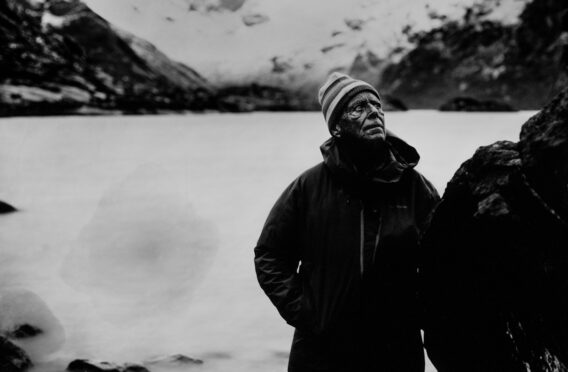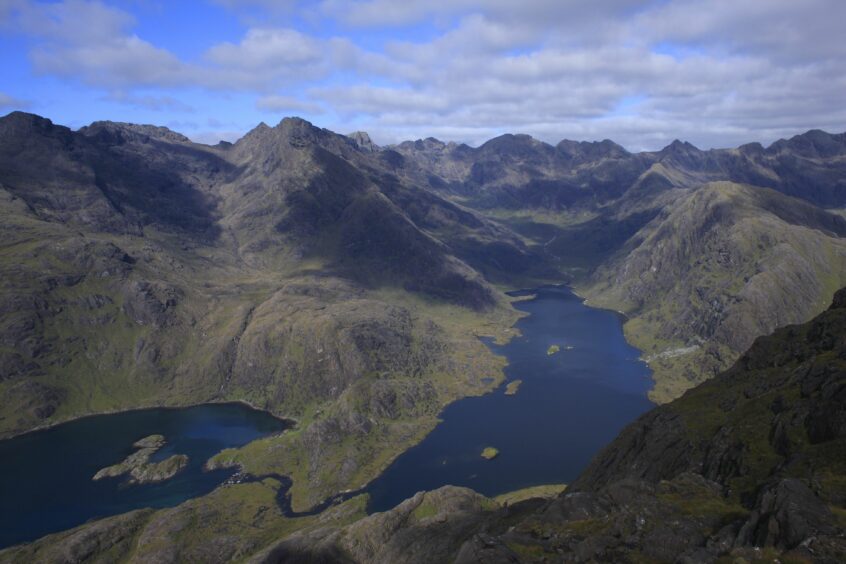
On a small, craggy peak on Skye, veteran mountain rescuer David Whalley looks upwards to the summit and remembers his longest night and hardest mission, writes Laura Smith.
On the 40th anniversary of a US military jet crash that killed both pilots, he returns to the site along with photographer Simon Riddell to raise awareness of mental health and the legacy of trauma.
Here, they explain why.
The mountain rescue legend
After a gruelling and treacherous hike across wet, icy terrain and deep snow, David “Heavy” Whalley catches his breath at the edge of Loch Coruisk as he gazes up towards the peak of Sgurr na Stri on Skye.
The 494-metre hill nestled between the jagged Black and Red Cuillin Mountain ridges is smaller than most peaks Whalley has climbed in his life, and yet it is where the former mountain rescue leader once spent the hardest night of his life.
While the landscape around him is magnificent, this place stirs heart-breaking memories in the former mountain rescue leader, who celebrates his 70th birthday this week. This trip is something of a pilgrimage for Whalley, whose first ascent of Sgurr na Stri was under similar weather conditions but far more harrowing circumstances.
He is here to mark the 40th anniversary of the night a USA F111 jet plane crashed into the southern side of Sgurr na Stri in the middle of a blizzard during a training mission on December 7, 1982. Then an RAF Mountain Rescue team leader based in Kinloss, Whalley led a group of five to search for survivors in brutal conditions.
“This place means a lot to me, so it is poignant being here,” said Whalley, who has returned with local mountaineer and photographer Adrian Trendall and Skye-based photographer Simon Riddell.
“I’ve done over 1,000 rescues but that was one of the hardest nights. We had no help. We couldn’t contact anyone. We had to stay on this hill all night in the middle of a snowstorm. It was hellish.”
While the dangerous terrain and ice and snow that at points came up to Whalley’s thighs stopped him reaching the crash site last week, the visit is still incredibly poignant. Trendall and Riddell manage to climb further and leave two memorial crosses for the fallen airmen below the crash site. “The conditions are identical to 40 years ago,” Whalley said. “It’s probably more dangerous than it was that night. I’m not as young as I was.”
Rusted debris from the wreckage is still scattered across the hillside and the ground is shattered and uneven due to the impact of the crash, which sent shockwaves so powerful three hillwalkers in a nearby bothy at the time told Whalley they thought a nuclear war had started.
Whalley, who joined the RAF in 1972, and his team had just finished a 12-hour shift when they got a call-out at 8pm for a crash on Skye, and 10 minutes later they were scrambled in a helicopter. “It was a whiteout so we had to get dropped off at the bottom of the hill. The chopper wrecked an engine trying to pull up so couldn’t come back for us,” Whalley said.
The RAF Mountain Rescue team dealt primarily with aircraft crashes across Scotland. In a time before mobile phones, GPS and decent night-vision equipment, Whalley and his team had only rudimentary kit on a long, exhausting ascent that saw them negotiate wet rock, fresh snow and burning wreckage.
“We had no comms. The gear we had was appalling, even for 1982, it was snowing and we’d all done a 12-hour shift. There was burning wreckage all the way up the hill. We knew it wasn’t a recuse mission when we found bits of the canopy. The wreckage was jagged so in the pitch dark it was very dangerous. There was still fire, smoke and fuel. In health and safety terms, nobody should be there but someone had to have a look.”
Eventually, Whalley and his team discovered the bodies of the pilot, Major Burnley Rudiger Jr, aged 37, from Norfolk, Virginia, and weapons system operator, 1st Lt Steven J Pitt, 28, from East Aurora, New York. They had been based in RAF Lakenheath in Suffolk and were both married fathers to two young children.
“I was up there with three other good guys. We were all struggling. I never went to sleep – I walked about all night trying to get comms. At 2am they were struggling with the cold while sitting beside this horrible trauma so I got everybody up and we waited four hours for daybreak. It was the longest night of my life and hard-going mentally. Finally, the weather cleared and the light came. We spent another five days on that hill helping with the inquiry.”
Whalley, who now lives in Burghead on the shores of the Moray Firth, retired from the RAF in 2007 after 36 years of service, which earned him a British Empire Medal, MBE and the Distinguished Service Award for Service to Mountain Rescue.
As he looks further up the hill, to where his team toiled to find survivors, Riddell undergoes the slow process of taking his picture using wet plate collodion photography to capture an image of Whalley. Riddell’s work aims to highlight his experiences with post-traumatic stress disorder – something Whalley also faced.
During his time in the RAF, Whalley was senior team leader at RAF Leuchars and RAF Kinloss and attended many serious plane crashes. The worst was six years after the Skye call-out, on December 21, 1988, when Whalley was a senior team leader at Lockerbie, and one of many rescuers who remains scarred by the disaster decades later. “When we got the helicopters down it was like Vietnam. There were no lives to save,” he said.
“The place was in turmoil. People lying on the ground, children, surrounded by wreckage and Christmas presents. I was in the military for 37 years and I’d seen death, we were dealing with 15 fatalities in the mountains every year, but I’d never experienced anything like that.”
“My team were tough guys but at least half were struggling. They were coming to me saying they couldn’t sleep, they couldn’t tell their wives what was going on. I realised we needed help but in the military in 1980s you did not ask for psychiatric help. I was told I was out of order, my superiors said I was weak, that I’d let the system down, but I pushed and pushed. Eventually, Professor Gordon Turnbull, an RAF psychiatrist and his team, came to speak to us. I’m glad things are much better today.”
Whalley recalls the impact undiagnosed PTSD had on him: “I couldn’t sleep, I had nightmares. I lost my rag at nothing. I was drinking because that was only way I could sleep. Then I woke up one morning and couldn’t get out of bed. It was like I was paralysed and that was my body saying enough’s enough. I stayed in bed for two weeks to recharge. I recovered from that but it never leaves you.
“Every week before Lockerbie, I’d withdraw. I know that, come the 35th anniversary next year, I’ll go away for a few days because it comes back to me. I’ve seen more than 50 tragedies and it built up and built up. I still get flashbacks. I had to mostly teach myself how to cope with it. Being in the mountains clears my mind and talking helps. It’s important for people to know there is a way out but you need to ask for help.”
Returning to crash sites like Sgurr na Stri is an important part of the healing process for Whalley. He also recalls his rescue missions through his blog, where many people connected to his rescues contact him, including the children of Lt Steven J Pitt, who died in the Sgurr na Stri crash. In the summer of 2019 Whalley and mountaineer Adrian Trendall took them to the crash site, where a grave marker honours the two pilots.
“It was very emotional but it was amazing to be here with Steven and Sarah,” said Whally. “We couldn’t save the crew but at least we’ve taken the family up and they’ve got something out of it, even 40 years later.
“When I think of that awful night on the hill and then that day of warmth and love, that makes it worthwhile.”
The photographer
As David “Heavy” Whalley looks up towards the peak of Sgùrr na Stri, photographer Simon Riddell was searching for light and performing complex alchemy within a tiny tent.
Riddell specialises in wet plate collodion photography, a complex process pioneered in 1851 by Frederick Scott Archer.
To get one shot, he must coat a piece of metal or glass with a collodion emulsion – a mixture of chemicals – bathe it in a bath of silver nitrate, then immediately load it into his large frame camera and expose it to UV light in front of his pre-framed shot.
For Riddell, the driving force behind this challenge is to inspire people to overcome adversity and raise awareness of mental health, particularly PTSD, which he experienced after the sudden death of his father, Keith Riddell, in 2016.
He said: “He collapsed one day while preaching at his church in Nigg, Ross-shire. I performed CPR for about 15 minutes before the ambulance arrived but we couldn’t save him. One day I was sitting in my car, just around the corner from where it happened, and I froze. I became anxious about everything.”
His photo of Whalley is the first phase in his Peak Perseverance project, where he will try to picture majestic yet brutal landscapes across the Cuillins.

Enjoy the convenience of having The Sunday Post delivered as a digital ePaper straight to your smartphone, tablet or computer.
Subscribe for only £5.49 a month and enjoy all the benefits of the printed paper as a digital replica.
Subscribe © FLPA/Shutterstock
© FLPA/Shutterstock